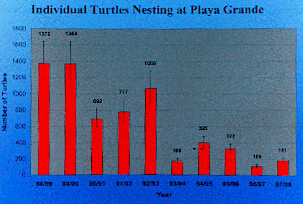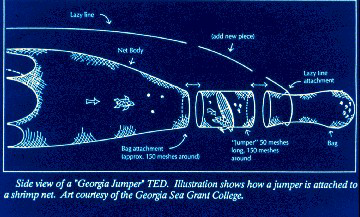Link to Courses
Are Leatherbacks Doomed to Extinction?
By Frank V. Paladino
Costa Rican Sea Turtles PI
Since the early 1980's
my colleague Dr. James R. Spotila and I have led teams of researchers,students,
and volunteers to Costa Rica to study leatherback and green sea turtles.
We were fortunate to get to know Sr. Mario A. Boza who has served in various
positions in the Costa Rican Ministry of the Environment (MINAE) including
|
as Vice Minister,
and in numerous Conservation NGO positions. Sr. Boza is fondly referred to
in Costa Rica as the father of the National Parks system and was a driving
force urging us to work in Costa Rica and help conserve sea turtles. The
National parks in Costa Rica are one of the leading ecotourist destinations
in the world and are renowned for their diversity, beauty and strong management
by MINAE. We have Provided the data to MINAE needed to develop a new
National Park "Parque Marino Las Baulas" to help protect leatherback sea
turtles along the Pacific coast in the Guanacaste Provence on Playa Grande
(photo #1). Over the past eight years we have had over 300 Earthwatch
volunteers, 20 graduate students and numerous undergraduates from the USA
and Costa Rica work with us on the scientific and conservation projects that
have resulted in over 30 publications in scientific journals. As a matter
of fact one Costa Rican student Sr. Rodney Pietra Chacon, who did his graduate
research working with us and his Costa Rican Professors from the National
University of Costa Rica on Playa Langosta, is now the Park Director.
To see a brief National
Geographic video on this project, click here.
|

|
|


|
Sadly over the
past 11 years we have watched the rapid decline of the leatherbacks from
a population that was about 1,350 female nesters per season to about 130
- 140 individual turtles who have nested there the past three years.
For a more detailed data go to our web page at http://www.coas.drexel.edu/environ/costa-rica/.
This decline is the result of over 15 years of almost complete harvest
of the eggs laid by returning females and the loss of many nesting beaches
to development for hotels, resorts, and private homes (see Figure 1 and photo
# 2 of poacher on horseback). We have also observed a greater than 40% mortality
in the returning adult female population over the last eight years. To be
sure that these female who have not returned are not just nesting elsewhere,
we have conducted aerial surveys and checked beaches all along the Costa
Rican coastline and found that there are few beaches left where the leatherbacks
still nest. The situation is the same all along the Central American coastline
from Mexico to Panama. At a recent meeting in January 1999 I spoke
with Ms Laura Sarti, a Mexican leatherback researcher, who relayed to me
some really depressing news. She reported that on the Pacific beaches of
Mexiquillo where there were approximately 1,000 female leatherbacks
nesting per year ten years ago now there was only one female who came ashore
to lay only two nests. Leatherback turtles and others are also caught on
long line fishery hooks. We, using satellite telemetry, followed the
|
| migrations of leatherbacks from the beaches in Parque
Marino Las Baulas into the Central Pacific. Our findings published
in the journal Nature (Morreale et al. 1996, Volume 384:319-320) indicated
that leatherbacks migrated along a narrow corridor about 100 km wide away
from the coast and out into the Pacific (Figure of migration). We, along
with another research team who was working with the Mexican, Mexiquillo
beach leatherback turtles, found that many of these satellite tagged
turtles seemed to hit a zone in the Pacific as they migrated away from
the nesting beaches where the transmitters and the turtles seemed to
disappear. Both our research team and theirs (see Eckert 1997 Marine
Turtle Newsletter 78:2-7) suspect that these turtles are being caught
on long line and gill net fisheries found in these waters near the
Galapagos and Easter Islands and off the coasts of Equador and Chile. Our
1996 research article in Chelonian Conservation and Biology (Spotila
et. al. 1996 Volume 2(2):209-222) describes the declines of leatherbacks
especially in the Eastern Pacific Ocean. We are very concerned that the population
model we presented in this paper which describes the effects of fishing pressure,
adult mortality, and loss of eggs due to harvest, on the survival of sea
turtle populations is being ignored. |

|
Recent rulings in
October 1998 by the World Trade Organization (WTO) have been of great concern
to marine conservationists. The WTO has ruled that the 1989 Turtle Excluder
Devise (TED) Law could not be enforced on the fleets of foreign importers
of shrimp. The TED law that was passed by the US Congress and finally signed
a few minutes before George Bush left the presidency was designed to protect
many marine species, especially sea turtles, from needlessly drowning as
a bycatch in the shrimp nets in USA waters. It also required any importer
of shrimp to the USA to also comply with these fishing practices so
|
that US shrimp
fishermen would not be undercut by cheap shrimp caught without the use of
these TED devices. The TED (Figure of TED) is simply a gate in the net that
allows for large marine species to escape from inside the nets. If these
turtles, marlin, tuna, and other large marine species are dragged in the
nets without these escape routes they are caught along with the shrimp and
damaged or drowned in the nets and just dumped overboard. The foreign importers
of shrimp argued that the USA TED law was forcing foreign fleets to comply
with USA laws and restricted free trade. The WTO ruled in October 1998 that
this US TED law was an infringement on free trade and see the Earth Island
web page at http://www.earthisland.org/strp/deathsentence.html
to check out the full details of this ruling and the arguments made concerning
this case. The bottom line is that sea turtles will be needlessly killed
because of the US appetite for shrimp. Shrimp fishing is one of the most
inefficient fisheries with 10 - 30 lbs of so-called bycatch that must be
dumped dead overboard for every 1 pound of shrimp caught. These shrimp fishing
practices along with the long line fisheries especially off the Pacific Coast
of Central America seem to have
|

|
had a dramatic effect
on the populations and migrations of sea turtles. It was estimated that over
20,000 turtles per year were killed and it may have been the leading cause
for the demise of the Kemp’s Ridley sea turtle in the Gulf of Mexico. Kemp’s
Ridley turtles were know to have nested on South Padre Island but were extinct
from those beaches by the 1950's. There remains now only one beach "Rancho
Nuevo" in Mexico where this most endangered sea turtle is found to nest in
arribadas that historically had thousands of turtles emerging and nesting
in these social aggregations in one - three nights a month but now these
arribadas number only in the hundreds.
The combined effect of the nesting beach habitat loss, indiscriminate
harvesting of eggs, the shrimp fishery, the long line and gill net fisheries
has been the rapid decline of many sea turtles, billfish and other large
marine species along the Central American coast. The ruling by the WTO and
the reluctance of many countries to sign the International Sea Turtle Conservation
Convention that is designed to protect these animals has led to the current
sorry state of affairs. I believe that these rulings and the lack of concern
will lead to the extinction of leatherbacks, at least in the Eastern Pacific,
unless something is done to change the patterns we now see. We have worked
hard to create new National Parks like Parque Marino Las Baulas to protect
and maintain the nesting beaches but now the animals are being indiscriminately
killed in the ocean by our fishing practices. We need to not only protect
the beaches but the adults in the ocean as the grow and return to nest.
As a personal crusade I have decided to not eat shrimp unless I
am sure they were obtained by a fleet using TED’s. In addition I have written
to all the seafood chains and fresh/frozen seafood processors in the USA and
pleaded that they continue to purchase only "Turtle Safe Shrimp" from fleets
that comply with the USA TED laws. I hope that any of the many volunteers
who have visited the many sea turtle projects sponsored by Earthwatch will
rise up and also write to these companies, their congress representatives
and whomever will listen to please save our oceans and these wonderful and
fascinating animals. If you would like you can send your messages and letters
to me at the following postal and e-mail addresses and I will forward them
along to the companies and governmental agencies:
Mailing Address:
Department of Biology
Indiana - Purdue University
Fort Wayne, IN 46805-1499 USA
Fax:(219)481-6087
E-Mail: Paladino@ipfw.edu




